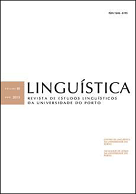Infinitival before and after-clauses in European Portuguese : temporal and aspectual properties
Resumo
The main goal of this paper is to discuss temporal and aspectual features of sentences with clauses introduced by the connectives antes de + Infinitivo (‘before’ + Infinitive) and depois de + Infinitivo (‘after’ + Infinitive) combined with situations in the Pretérito Perfeito in European Portuguese. Our discussion is based on the widespread view that these clauses are locating adverbials (cf. Kamp and Reyle (1993)) with temporal information of anteriority, in the case of antes de, and posteriority, in the case of depois de. However, this analysis is not as straightforward as one would expect, because, while before-clauses consistently render the same temporal relation (of anteriority), after-clauses may convey a temporal relation of inclusion, in addition to the standard posteriority relation. We put forward the hypothesis that aspectual characteristics play an important role in these differences, insofar as allowing a temporal reading that at first sight is not predicted from the semantic nature of the connective. In order to maintain a uniform treatment of before and after-clauses with respect to their temporal features, accounting simultaneously for the differences that emerge in their linguistic behaviour, we claim, along with Beaver & Condoravdi (2003) and Condoravdi (2010), that the locating time interval provided by these clauses is bounded to the left, but not to the right, that is, what is focused is the initial frontier of the situation that provides the time interval, leaving the final one undetermined. Furthermore, we show that, although the temporal mechanisms are parallel, the interference of aspectual properties leads to interesting differences in the final interpretation of before and after-sentences.
Referências
Beaver, D. & Condoravdi, C. 2003. A Uniform Analysis of Before and After. In: R. B. Young, & Y. Zhou, (Eds.). Proceedings from Semantics and Linguistic Theory XIII. Ithaca: Cornell University, 37-54.
Condoravdi, C. 2010. NPI licensing in temporal clauses. Natural Language & Linguistic Theory. 28:4, 877-910.
Cunha, L. F. 2004. Semântica das Predicações Estativas. Para uma Caracterização Aspectual dos Estados. PhD Dissertation. Porto: Faculdade de Letras da Universidade do Porto.
Declerck, R. 2006. Adverbial Before-clauses and After-clauses. The Grammar of the English Tense System. Berlin: Mouton de Gruyter.
García Fernandez, L. 1999. Los Complementos Adverbiales Temporales. La Subordinación Temporal. In: I. Bosque & V. Demonte (Eds.). Relaciones Temporales, Aspectuales y Modales. Volume 2, Chapter 48. Madrid: Editorial Espasa Calpe, S.A., 3129-3208.
Heinämäki, O. 1974. Semantics of English Temporal Connectives. PhD Dissertation. Austin: University of Texas (reproduced by the Indiana University Linguistics Club, Bloomington, 1978).
Hinrichs, E. 1986. Temporal Anaphora in Discourses of English. Linguistics and Philosophy, volume 9, 1. D. Reidel Publishing Company, 63-82.
Kamp, H. & Reyle, U. 1993. From Discourse to Logic: Introduction to Modeltheoretic Semantics of Natural Language, Formal Logic and Discourse Representation Theory. Dordrecht: Kluwer Academic Publishers.
Krifka, M. 2010. Before and After without Coercion: Comment on the Paper by Cleo Condoravdi. Natural Language and Linguistic Theory. 28: 911-929.
Lobo, M. 2013. Subordinação adverbial. In: E.P. Raposo et al. (Eds.). Gramática do Português. Lisboa: Fundação Calouste Gulbenkian. Volume 2. 1981-2057.
Lopes, A. C. M. & Morais, M. da F. 2000. Antes e Depois: Elementos para uma Análise Semântica e Pragmática. Revista Portuguesa de Filologia. Volume XXIII, 1999 – 2000: 183-243.
Marques, R. & Alves, A. T. 2014. Sobre as variações de modo nas frases subordinadas temporais com antes. In: Textos Selecionados do XXIX Encontro Nacional da Associação Portuguesa de Linguística. Porto: APL, 333-343.
Moens, M. 1987. Tense, Aspect and Temporal Reference. PhD Dissertation. Edinburgh: Centre for Cognitive Science, University of Edinburgh, Scotland.
Moens, M. & Steedman, M. 1988. Temporal Ontology and Temporal Reference. Computational Linguistics. Volume 14, number 2: 15-28.
Móia, T. 2000. Identifying and Computing Temporal Locating Adverbials with a particular focus in Portuguese and English. PhD Dissertation. Lisbon: Faculdade de Letras da Universidade de Lisboa.
Oliveira, F. & Lopes, A. 1995. Tense and Aspect in Portuguese. In Thieroff, R. (Ed.) Tense Systems in European Languages II. Tübingen: Max Niemeyer Verlag, 95-115.
Oliveira, F. 2003. Tempo e Aspecto. In M. H. Mateus et al. Gramática da Língua Portuguesa. Lisboa: Ed. Caminho.
Oliveira, F. (2013) Tempo Verbal. In. Raposo, E.P. et al. (Eds.). Gramática do Português. Volume II. Lisboa: Fundação Calouste Gulbenkian, 509-556.
Partee, B. 1984. Nominal and Temporal Reference. Linguistics and Philosophy. 7: 243- 286.
Silvano, P. 2010. Temporal and rhetorical relations: the semantics of sentences with adverbial subordination in European Portuguese. PhD Dissertation. Porto: Faculdade de Letras da Universidade do Porto.
Downloads
Publicado
Edição
Secção
Licença
Direitos de Autor (c) 2017 Linguística Revista de Estudos Linguísticos da Universidade do Porto

Este trabalho encontra-se publicado com a Creative Commons Atribuição-NãoComercial 4.0.



